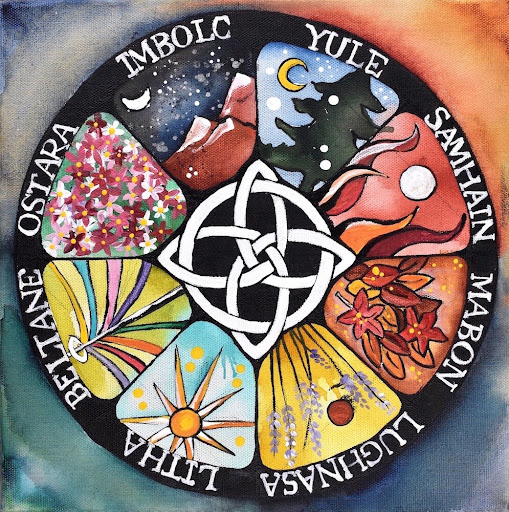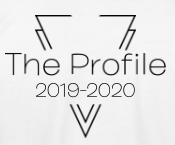Solar Celebrations
What is Wheel of the Year?

December 17, 2021
As we have come to the end of Halloween and we are now in November, I felt that it would be fun to talk about an interesting subject: the Wheel of the Year. First of all, what is the Wheel of the Year? It is a series of seasonal festivals that consist of the year’s solar events and the points between them. In other words, it is a bunch of seasonal celebrations that are like Christmas or Halloween that are usually celebrated by modern day Pagans. The dates of these festivals do vary from year to year, so I will be talking about the 2021 Wheel of the Year. Also, this all corresponds to the Northern Hemisphere and the Northern Hemisphere seasons. In this article, I will talk about each of the different festivals and their importance to the Wheel of the Year.
Before talking about the festivals themselves, it is important to understand what solstices and equinoxes are. This is important because the Wheel of the Year is the solar events as well as the midpoints between them. In astronomy, a solstice is when the sun reaches either it’s highest or lowest point of the year. “Solstice” is a combination of Latin words “sol” meaning sun and sistere meaning “to stand still.” This is related to the fact that astronomers see the solstice as the point in the year where the “sun appears to be standing still.” On the other hand, the equinoxes are the time of year when the sun crosses the celestial equator. This is when night and day are the same amount of time. Now that the general definition of solstice and equinox are known, it is time to talk about the sabbats of the Wheel of the Year.
A “sabbat” are the different solstices, equinoxes, and midpoints. It is simply just a fancy word for the festivals. The Wheel of the Year begins with the first festival, Imbolc. On February 1-2, pagans celebrate the Irish holiday that is also referred to as Saint Brigid’s Day. This day marks the beginning of spring and for Irish Christians, is celebrated as the “feast day” of Saint Brigid. This celebration was originally largely celebrated through Ireland, Scotland, and the Isle of Man. This is one of the four Gaelic festivals, the other three being Beltane, Lughnasadh, and Samhain. In the present day, neo-pagans and Christians still follow the holiday. It is largely celebrated by honoring the Celtic goddess Brighid, creating altars in honor of the holiday and goddess, or simply following traditions like Valentine’s Day.
About a month and a half later, the Ostara celebrations commence. Ostara (pronounced oh-star-ah), also known as the Spring equinox, honors the beginning of spring. Similarly to Imbolc, Ostara is named after an Anglo-Saxon goddess, Eostre. Eostre is a West-Germanic spring goddess who represents new beginnings. In some languages, she is the namesake for Easter, celebrated by many Christians. Ostara, like many spring celebrations, symbolizes fertility, rebirth, and renewal. Many pagans celebrate this holiday by decorating their altar to match with spring, planting seeds in a garden or even creating a garden. Many pagans will also take this time to create new goals for the coming year to represent their personal new beginnings.
Beltane is then celebrated on May 1st, the midpoint between the spring equinox, Ostara, and the Summer solstice, Litha. Beltane comes from the Celtic word “Bel” referring to the sun god Belenus. May 1st is typically the first day of summer in Ireland, which leads to its celebration in Ireland as well. Before Christianization in Rome occurred, Romans widely celebrated Beltane to honor Flora, the Roman goddess of flowers. In more recent years, this celebration is more well known as May Day which is well known for the maypole. Beltane is celebrated by modern pagans with bonfires, honoring deities, and as stated, doing a maypole ritual.
As stated previously, Beltane is the midpoint of Ostara and Litha. Meaning, the next Wheel of the Year festival is the well-known Summer solstice or Litha. Celebrated on June 24th, Litha is one of the four solar holidays where summer reaches its height and the sun shines the longest. Much like Beltane, Litha is celebrated very similarly with flowers, bonfires, honey, and overall just worshiping and thanking the different gods and goddesses. There wasn’t much information I could find on the origins of Litha, but all in all it seems like a fairly well known and loved festival.
Shortly after Litha, Lughnasadh is celebrated on August 1st. Lughnasadh (pronounced lu-nah-saw) is the beginning of the Gaelic harvest season. This celebration corresponds to the Welsh harvest festival Gŵyl Awst and the English Lammas. Lughnasadh is mentioned in early Irish literature showing its pagan origins. The festival is named after the god Lugh who was largely associated with the arts, craftsmanship, and overall being seen as a savior. In modern days, Lughnasadh is celebrated by baking, eating seasonal fruits and vegetables, or even simply partying with friends and family.
Following the short celebration of Litha, the long-term festival of Mabon begins its celebrations on September 21st through the 29th. There was little I could find about the origins of Mabon, similarly to that of Beltane, but it is celebrated as the pagan Thanksgiving. It is a week-long period to be thankful and celebrate friends and family.
Modern pagan then celebrate Samhain on Halloween and in some years, September 1st. Pronounced saw-in, Samhain is the final Gaelic festival which marks the end of harvest season and the beginning of winter. Similar festivals are celebrated by Brittonic Celtics called Calan Gaeaf in Wales and Kalan Gwav in Cornwall. Pagans celebrate the holiday by feasting, dancing, going on nature walks, or even building altars to honor ancestors.
Finally, ending the Wheel of the Year is Yule or the Winter solstice. Yule dates from December 21 through January 1. Yule was originally observed by the Germanic people which is largely connected with the Wild Hunt, the god Odin, and the pagan Anglo-Saxon Mōdraniht (pronounced Mah-dro-nit). This festival went under Christianized reformulation which created what is now known as Christmas. Despite this, the twelve day festival lives on for many modern-day pagans, who use the period to celebrate family, cleanse both themselves and the house, and have many baking festives either to honor themselves or their Gods/Goddesses.
In conclusion, the Wheel of the Year is just another list of celebrations that pagans have much like other religions. It is a wonderful way to connect with friends, family, and even the self in a multitude of ways. All in all, I hope this article encourages you to look into these holidays and even possibly celebrate one yourself. There is no wrong way to celebrate these festivals, and much like Christmas or Thanksgiving, everyone makes their own traditions.

